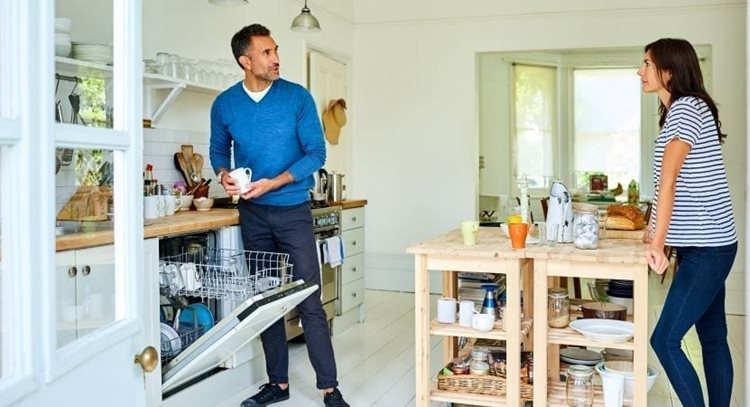
Moving In Together? 15 Relationship-Saving Tips From the Experts
Moving Tips and Hacks
So you’re thinking of moving in with your boyfriend or girlfriend? Congrats! Moving in together is both an exciting and scary proposition. Up until now, you’ve probably only seen your beloved in their own environment and, possibly, on their best behavior. Moving in together means seeing all of your partner’s sides every single day.
Cohabitation is the most popular living arrangement in the U.S. — 67 percent of the household population has chosen this path. But more and more couples are choosing to cohabitate for a longer duration before getting married (if they ever tie the knot at all).
Moving in together presents its own set of unique challenges, including splitting chores, sharing expenses, and figuring out how much time to spend together — and that’s just for starters.
We spoke to three relationship experts for tips and advice on how to make moving in with a partner go as smoothly as possible. From questions to ask before moving in together to important discussions you need to have, consider this your moving-in-with-a-boyfriend (or girlfriend) checklist.

Commitment or convenience? One of the things to discuss before moving in together.
1. Decide, Rather Than Slide, Into Moving In Together.
Sometimes, moving in with a partner is done out of convenience. There can be all kinds of practical reasons for moving in together — your lease is up, you spend so much time at your partner’s place anyway, you’ll both save money, your roommate just moved out, etc. Maybe you don’t even live in the same city, and one of you is ready to move cross-country to alleviate the inconvenience and expenses of traveling back and forth.
Regardless of all the external factors, it’s important to make a conscious decision that moving in together is the right next step for your relationship.
“You want to make sure it makes sense toward the arc of commitment in your lives,” says Dr. Alexandra H. Solomon, Licensed Clinical Psychologist and founder of the Institute for Relational Self-Awareness. “I want people to find ways to make space for a conversation about why they’re moving in together. Looking at the ‘why’ instead of just the pragmatic aspects of cohabitation.”
Lisa Concepcion, a Certified Life Coach with LoveQuest Coaching, says she often sees clients moving in together way too fast — and for the wrong reasons.
"I see a lot of people moving in with their boyfriend because they want emotional nurturing or a mother/father figure to take care of them," she says. "Others might be inclined to depend on their partner financially."
Having a conversation about the goals and the whys of moving in together is a big first step toward making cohabitation a reality. Does one person think moving in together means marriage, while the other doesn’t? Would you rather be engaged before moving in with your partner? Or are you both okay with simply living together with no further commitment?
Make sure you feel ready — financially and personally — to join lives with another person.
| Q: How long should you date before moving in together? A: Most couples move in together a year or two into dating. Moving in with your girlfriend or boyfriend, though, should be determined by emotional connection rather than longevity. When couples move in together is less important than why they move in together. Whenever you both decide that you want to live together, it’s smart to start the conversation months before you actually end your lease and pack up, so you have plenty of time to discuss logistics like finances, chores, and contingency plans — and go through this moving-in-together checklist before moving in with your partner. |
2. Find the Right Move-In Date.
When do couples move in together? Some wait years, while others jump the gun and do so after only a few weeks of dating. Even if you’re excited about moving in with your boyfriend or girlfriend, it’s best to give the process some time, so you and your partner can go through the important things to discuss before moving in together. Plus, you’ve got some packing to do!
Concepcion recommends signing a lease together on a new place and doing so intentionally. “Look at when your leases expire and plan a date when you’ll move in together. If one of your leases ends sooner, ask your landlord for a few extra months, during which you can pay rent month to month. Then, if the time rolls around and one of you gets cold feet, you still have a place to live,” she advises.

Are you moving into a new space together — or will the space be new to only one of you?
3. Figure Out Where You’ll Move In Together and What You’ll Bring.
Many people decide to move into the other person’s house or apartment, but if you decide to do so, there are some things to discuss before moving in together.“In an ideal world, it’s nice to move into a space that’s fresh without any memories of the past,” says Minal Nebhnani, Licensed Professional Clinical Counselor with Honest Space Psychotherapy. “But if someone is moving into someone else’s space, treat it as a new space rather than someone else’s old space. The person moving in should have an equal say about what stays and what goes, how to decorate, etc. They should feel the space is theirs as much as it is their partner’s.”
Have a conversation about which furniture you’ll bring, what you’ll store, and what you’ll buy together. Moving in together is a great time to downsize, get rid of stuff, or get a storage unit to keep larger items you won’t need in your new place together. You’ll also want to plan your moving process, whether you’re moving locally or long-distance. Will you need to rent a truck, hire full-service movers, or use a portable moving container to make downsizing and storage easier?
4. Talk About Chores and Money Before Moving In With a Partner.
Chores and money are major fight triggers in a relationship, and it’s important to hash out the details before moving in with a girlfriend or boyfriend. Who will do the laundry — or will you each handle your own? Who’s in charge of cooking and doing dishes? Who takes out the trash? These questions to ask before moving in together should be hashed out before the big transition.
Solomon encourages couples to make an agreement rather than a compromise when talking about chores. “Agreement implies both people are invested in the plan,” she says, “while compromise highlights the fact that both people aren’t getting what they want. It can be a good idea to write out your agreement so everything’s clear and on paper.”
According to Solomon, that’s because who does what around the house can trigger old childhood wounds.
“When couples move in together, it’s where old family issues are played out,” says Solomon, author of Loving Bravely: Twenty Lessons of Self-Discovery to Help You Get the Love You Want. “If I’m cooking and you’re watching TV, I feel you have become my absent father, and I’m my overworked, resentful mother.”
Money is also a big issue to talk about before moving in together. Have an open and honest dialogue about who is paying for what. This is not a roommate situation, where you’re moving in with a friend. So consider the following: Will you split the rent, or will one person pay rent and the other be in charge of food and bills? Do you put money into a joint account for household expenses or do you keep your own separate accounts?
“However detailed you can get about the way things are going to operate, the better,” says Concepcion. “This is a huge, necessary conversation, and people need to be on the same page before they cohabitate.”

Live together for a week or two before deciding that moving in with your boyfriend or girlfriend is the right choice.
5. Do a Test Run.
Maybe you and your partner have taken some trips together or spent a couple weekends binge-watching your favorite movies and enjoying takeout. That’s not the same as moving in with your boyfriend or girlfriend and sharing your day-to-day life.
Live together for a week or two before deciding that moving in with your boyfriend or girlfriend is the right choice. Go into the exercise with the mindset that you’ll each behave as you would in your regular homes. This gives you time to get to know each other on a deeper level, and you’ll have time to go through some questions to ask before moving in together officially.
6. Make Contingency Plans In Case of a Breakup.
Nobody wants to talk about breaking up when you’re on the cusp of something exciting like moving in together, but these types of conversations are important.
“People think they are going to jinx their relationships if they talk about breaking up,” says Solomon. “There is a way to talk about it. For example, you could say: ‘While all our energy is going into making this a successful, wonderful next step, we do need to talk about what happens if it doesn’t work out.’”
She recommends keeping money separate, at least at first. Later on, couples can create a joint checking account to deal with household bills.
Concepcion says furniture and the lease agreement are also important topics in case of a breakup. “Make sure you both have an understanding as to who will get the furniture, who leaves and who stays in the apartment, do you forfeit the security deposit, and what happens if you’re buying property together and you’re both on the deed.”
If moving in with your boyfriend or girlfriend means also buying property together or taking out a mortgage, she says you may want to consider hiring an attorney to draft an agreement that can stand up in court.
“Make sure this is an open, honest, and loving conversation,” says Concepcion.
| Q: Is it common to break up after moving in together? A: Breakups are no fun to think about, but they happen all the time. Recent studies show that around 43 percent of first marriages end in divorce, so if moving in together is a step toward matrimony, breaking up is a real possibility. While not as exciting to discuss as what kind of couch to get for your new shared place, talking about what will happen if you break up — who moves out, how you’ll split things up, etc. — and writing it down in an agreement is a wise way to keep things as civil as possible in the event that does happen. |

Moving in with your partner shouldn’t mean losing your individuality.
7. Remember To Make Time for “Me Time.”
Moving in together is an exciting step in a relationship, and you may be tempted to spend all your waking hours with the other person. But it’s still important to maintain your own sense of individuality. Create a little corner of the space that’s all yours, like a reading nook tucked away in a private spot.
Also, be sure to schedule time away from the other person. “Continue seeing your friends, going out on your own, having your own life and hobbies,” says Nebhnani. Besides helping you maintain your sense of self, keeping up with your own friends and hobbies ensures you always have something new and exciting to talk about at the dinner table.
8. Rethink Self-Talk.
No matter what kind of relationship you’re in, reevaluating language can be a big part of moving in with your significant other.“I have been a couples therapist for over two decades, and what I know for sure is that the word ‘lazy’ needs to be banned from our relational vocabulary,” Solomon wrote in an article on rethinking laziness. “When we chalk our partner’s behavior up to laziness, we’ve written the entire story — beginning, middle, and end — and left no room for our partner to co-author with us.” In some scenarios, you might even be tempted to label yourself as lazy. In either case, reevaluating your language is a productive way for you both to feel heard.
“Resist the urge to say, ‘You didn’t put the fresh roll of toilet paper on the thingy. You’re so lazy!’ Instead, ask what therapists call a constraint question: ‘What keeps you from putting the fresh roll of toilet paper on the thingy?’” writes Solomon. “This question positions you and your partner on the same side of the issue. You are inviting your partner to explore with you the blocks to what you perceive as a simple behavior.”

Dividing household chores is one way to keep resentment at bay.
9. Expect Bumps Along the Road.
Do relationships change when you move in together? They often do, because you can no longer hide the quirks and habits that are hidden when you’re on your best behavior. Also, being together more often means more opportunities for disagreements.
A lot of people approach moving in together, getting married, and having kids with a highly romanticized viewpoint. This is a risky way to think about cohabitation because you’ll get frustrated when things don’t go as planned.
“I want couples to anticipate and expect that real life is far messier and bumpier than the idealized view,” says Solomon. “There’s an element of sharing domestic life that is just a grind because there are so many points of possible friction. My way vs. your way, my definition of normal vs. yours, my needs vs. your needs. There are just so many more opportunities for conflict.”
When you do have conflict in your relationship, Solomon wants to remind you to focus on the positive and what’s going well. “When we’re scared, we tend to focus on what’s hard, our losses, or the downsides to a situation,” she says. “Instead, try to focus on the good things.”
Expecting bumps when you’re living together means you’ll be able to handle them better rather than feeling surprised and let down.
| Q: How long should you date before moving in together? A: The romantic answer is easy: “Oh, you’ll just know.” But the realistic answer is quite different. And it’s not one-size-fits-all. The strength of your relationship, your specific financial situation, the goals each of you has for the future — these are just some of the things to consider when you’re thinking about moving in with a partner. A wise course of action is to take into account all of the tips and thoughtful advice our three experts have offered — including the trial run, which is essential — and then make your decision on timing. |
10. Embrace Vulnerability.
In her blog, Solomon touches more on what real life looks like after moving in with your partner, and she gives three tips to keep in mind.While going through the things to discuss before moving in together, remind each other that — while there will be plenty of “me” time — you and your partner will also see each other at all times of the day.
For some, this won’t feel like the end of the world, but for others, it can be terrifying. Knowing that you have the strength to be seen, especially by your partner, is essential when you’re thinking about moving in together.
It can require a lot of soul searching and maybe even meeting with a couples’ therapist.
“We know that relationship conflict is inevitable, and we know that transitions tend to spike conflict,” writes Solomon. “What matters less is if you and your partner experience friction. What matters more is how you handle it.”
She goes on to outline three steps: Let yourself be seen, ask yourself the “Mirror Question,” and focus on the good.
1. Give Yourself Some Grace.
The first step is going to be accomplished fairly easily. If you wake up anxious, decide to skip that workout, or simply have a bad day at work, your partner is going to be there through it all, and that can be incredibly uncomfortable.
“Your best and bravest path is to be honest and direct when you are struggling … Remind yourself that you don’t need to bring your A-game in order to be worthy of love,” writes Solomon.
2. See Yourself More Clearly.
From there, the “Mirror Question” comes into play. Really, it’s as simple as getting into the habit of asking yourself, “What is it like to be with me right now?” By doing that, it’s a lot easier to understand the impact that your words and actions are having at home, and it can open the door for more conversations during this transition.
3. Remain Positive.
Finally, sometimes focusing on the good is the best possible thing you can do. “When fear is in the driver’s seat, it is easy to become hyper-focused on the bumps and miss out on the blessings,” Solomon writes.
If you grew up in a home that encouraged criticism over love, make it a habit to let your partner know when they’re doing well. It helps foster a safe environment instead of an icy one.

Talking about feelings can be uncomfortable, but it prevents bigger issues later.
11. Communicate, Communicate, Communicate!
Moving in together means there will be lots to discuss — constantly! You’ll be learning as you go along, possibly discovering things about your partner you never knew before. While some of those things might be cute, others might be downright annoying.
What’s important is that you communicate.
“People are going to have a lot of new feelings they haven’t thought about or expressed before,” says Nebhnani. “All these new feelings are natural, but it's good to talk about them rather than bottling them up and exploding later. Choose a time every week for a check-in. You can have a running list of things that bother you, and during check-in time, bring them up with your partner.”
Communication can make or break a relationship, especially during times of stress. While there are plenty of things to discuss before moving in together, the true test will be how well you keep having those conversations long after you sign the lease and unpack your boxes.
| Q: How long does it take to adjust after moving in together? A: We’d like to say that the adjustment will be short and easy — especially if you follow the guidance of our experts. But even with all the planning and consideration, it might take a little time to get used to strange-seeming quirks and habits after moving in with your partner. Still, if you keep your focus on being open with one another and staying vigilant about communication, it’s likely that you’ll both get used to the new configuration in due time — especially if you keep having fun. |
12. Talk About the Future.
While you’re communicating, one of the things to discuss before moving in together is what happens down the road. Do you see moving in with your boyfriend or girlfriend as a path to marriage? Does he feel the same way? Once married, do you want a family? It may sound daunting to mention these questions and expectations to your partner — perhaps because you’re anxious about how they’ll respond. But not knowing his mindset before moving in together can lead to even tougher conversations down the road.
13. Know How To Approach Conflict.
If you find that you’re struggling, adopt a “we” perspective over a “me” perspective — but don’t carry that language into your conversations. It might sound cheesy, but if you’re learning to approach conflict in a healthy way for the first time, “I” statements are important to incorporate into your vocabulary.
Remember, when moving in with your partner, you’re going to be approaching any issues together. Your feelings, however, are still your own. It’s important to keep in mind that their actions are making you feel a certain way, but they don’t define your entire relationship.
“It’s really easy to point a finger and see what our partner is doing,” writes Solomon. “It’s harder to see how our words and actions contribute to a problem.”

Moving in with your partner is work… and play!
14. Have Some Fun!
While moving in together poses its own set of challenges, it’s also a unique opportunity to really get to know and have fun with your partner. Now that you’ve made it through this moving-in-together checklist, think of new and exciting things to do together — maybe explore ballroom dancing, get your scuba certifications, or take up an outdoor activity like cycling.
Moving in with your boyfriend or girlfriend is also a great opportunity to get to know yourself and your own triggers. A partner provides a mirror that shows you what you need to improve.
With open communication and a positive attitude, moving in together just might be the best decision you’ve ever made.

PODS has the flexibility to navigate the logistics of moving in with your partner.
15. Trust PODS To Make Moving In Together Smooth and Easy.
Once you and your partner have decided to make the move, the next steps are all about where, when, and how. The PODS Blog has some terrific city guides. Start your planning process as soon as possible — it’ll help mitigate some of the inevitable hassles that can arise between the two of you. And finally, let a portable moving and storage container from PODS make the entire process easier. The container will be dropped off right in front of your house — and one at your partner’s place, too, if necessary! — and you can pack and load on your own schedule. And the best part? One month's storage is included in each rental, which means the two of you can unload and set up your new home on your own time.
Kristin Hanes is a freelance writer and blogger living in San Francisco. Her work has appeared in SF Gate, Marie Claire, and Realtor.com, among other publications.
Related Articles
Comments
Leave a Comment
Your email address will not be published. Required fields are marked *
